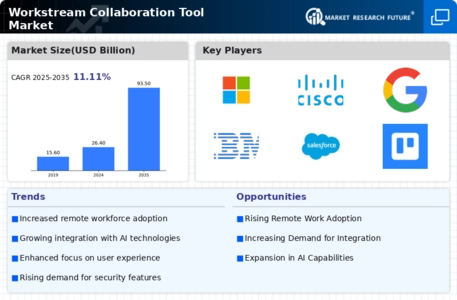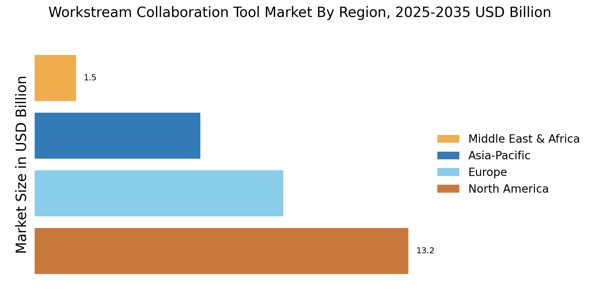Growing Focus on Data Security
The Workstream Collaboration Tool Market is increasingly shaped by the growing focus on data security and compliance. As organizations handle sensitive information, the need for secure collaboration tools becomes critical. Recent surveys indicate that over 60% of businesses prioritize security features when selecting collaboration tools. This heightened awareness of data protection is driving the development of tools that offer robust security measures, such as end-to-end encryption and compliance with industry regulations. Consequently, the Workstream Collaboration Tool Market is likely to expand as companies seek solutions that not only enhance collaboration but also safeguard their data.
Demand for Customizable Solutions
The Workstream Collaboration Tool Market is experiencing a rising demand for customizable solutions that cater to diverse organizational needs. Companies are increasingly seeking tools that can be tailored to their specific workflows and processes. This trend is supported by data indicating that 75% of organizations prefer collaboration tools that offer customization options. As businesses recognize the importance of aligning tools with their unique requirements, the Workstream Collaboration Tool Market is expected to grow. This demand for flexibility may lead to the development of more modular and adaptable collaboration solutions, allowing organizations to optimize their collaboration strategies.
Integration of Advanced Technologies
The Workstream Collaboration Tool Market is witnessing a surge in the integration of advanced technologies such as artificial intelligence and machine learning. These technologies enhance the functionality of collaboration tools, enabling features like automated task management and intelligent scheduling. As organizations increasingly adopt these technologies, the demand for sophisticated collaboration tools is expected to rise. Market data indicates that the integration of AI in collaboration tools can improve productivity by up to 30%. This trend suggests that the Workstream Collaboration Tool Market will continue to evolve, with a focus on incorporating innovative technologies that streamline workflows and enhance user experience.
Rising Importance of Team Collaboration
The Workstream Collaboration Tool Market is significantly influenced by the increasing recognition of team collaboration as a critical factor for organizational success. Research suggests that organizations with effective collaboration practices are 5 times more likely to be high-performing. This realization drives companies to invest in collaboration tools that enhance teamwork and communication. As a result, the Workstream Collaboration Tool Market is poised for growth, with businesses seeking solutions that foster collaboration across departments and geographical boundaries. The emphasis on collaborative work environments is likely to shape the development of new features and functionalities within these tools, further driving market expansion.
Increased Demand for Remote Work Solutions
The Workstream Collaboration Tool Market experiences heightened demand for solutions that facilitate remote work. As organizations adapt to flexible work arrangements, the need for tools that enable seamless communication and collaboration becomes paramount. According to recent data, approximately 70% of companies are investing in collaboration tools to enhance productivity among remote teams. This trend indicates a shift in workplace dynamics, where traditional office settings are being replaced by virtual environments. Consequently, the Workstream Collaboration Tool Market is likely to see sustained growth as businesses prioritize tools that support remote collaboration, ensuring that teams remain connected and efficient regardless of their physical locations.


















Leave a Comment